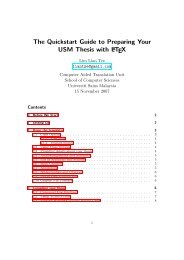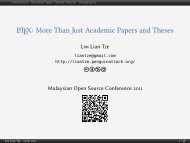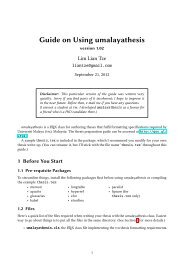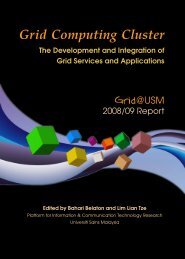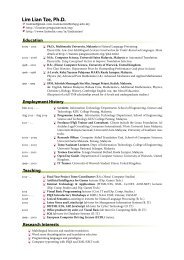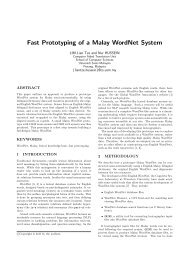A Formal Test Specification Translator using Ontol... - ResearchGate
A Formal Test Specification Translator using Ontol... - ResearchGate
A Formal Test Specification Translator using Ontol... - ResearchGate
You also want an ePaper? Increase the reach of your titles
YUMPU automatically turns print PDFs into web optimized ePapers that Google loves.
Malaysian Software Engineering Conference (MySEC’05)<br />
A <strong>Test</strong> <strong>Specification</strong> Code <strong>Translator</strong> Using <strong>Ontol</strong>ogy and<br />
XML/XSLT Technologies<br />
Lim Lian Tze, Tang Enya Kong and Zaharin Yusoff<br />
Computer Aided Translation Unit<br />
School of Computer Sciences<br />
Universiti Sains Malaysia<br />
Penang, Malaysia<br />
{liantze, enyakong, zarin}@cs.usm.my<br />
ABSTRACT<br />
<strong>Test</strong>ing equipment from different vendors utilise different syntax for their test specifications, but writing<br />
specifications for the same tests on different platforms is labour-consuming and error-prone. We present a<br />
prototype system for the automatic translation of test specifications between platform-specific languages,<br />
the framework of which is reusable for similar scenarios or software projects. We first design a generic<br />
representation scheme for test specifications. To perform a translation from a source language S to a<br />
target language T, a context free language parser module reverse-engineers test specifications in language<br />
S to a platform-independent equivalent in the generic syntax, marked up with XML. An XML/XSLT-driven<br />
generator module then transforms the platform-independent test specifications to language T syntax. In<br />
addition, we encapsulate knowledge about the tester domain in an ontology to facilitate the translation<br />
process. We also found ontologies to be helpful tools for requirements gathering, analysis and design.<br />
KEYWORDS<br />
Template-based code generation, domain modelling, ontology, context free grammar, XML, XSLT.<br />
1. Introduction<br />
<strong>Test</strong>ing equipment from different vendors<br />
employ different code syntax for developing test<br />
programs. This is mainly because vendorspecific<br />
tester syntax has been specialised and<br />
configured to make full use of vendor-specific<br />
tester capabilities.<br />
Writing test specifications for different platforms<br />
manually is time and labour consuming, as well<br />
as error-prone. We present a prototype<br />
translation engine for the automatic translation of<br />
test specifications in different platform-specific<br />
languages, by approaching the problem as one of<br />
code generation and translation. This engine<br />
will be able to:<br />
• generate tester-specifications for different<br />
vendors based on a generic tester language<br />
syntax,<br />
• reverse-engineer vendor-specific tester syntax<br />
to generic tester language syntax.<br />
Our solution employs technologies such as the<br />
Extensible Markup Language (XML), Extensible<br />
Stylesheet Language Transformations (XSLT),<br />
ontologies, context free grammar (CFG) and<br />
parser generators. The final framework, in part<br />
or whole, is reusable for solving problems of a<br />
similar nature. In Section 2, we describe the<br />
problem briefly, while Section 3 gives a short<br />
background on generation in software<br />
development. This is followed by a description<br />
of the architecture design of our translation<br />
engine in Section 4, which is further illustrated<br />
with an example in Section 5. Finally, Section<br />
6 and 7 concludes this paper by proposing<br />
possible future work and a short summary.<br />
2. Background<br />
Each vendor-specific language has its own syntax.<br />
For example, language A has a C-like syntax,<br />
while language B has both Lisp-like and<br />
tabular structures. In addition, each language<br />
has different names for the test schema types, parameters,<br />
and enumeration values. (We refer to<br />
these as test keywords henceforth.) Code snippets<br />
in languages A and B implementing the same test<br />
block are shown in Figure 1 and Figure 2.<br />
test_template_instance t1 schema1<br />
{<br />
binding1 = 0,<br />
binding2 = "operation1",<br />
binding3 = "-0.05, 0, 0.05"<br />
}<br />
Figure 1: <strong>Test</strong> Block in Language A<br />
define-instance t1 template1 (<br />
(define param1 0 :choice "No")<br />
(define param2 operation1)<br />
(define param3 -0.05 0 0.05)<br />
)<br />
Figure 2: <strong>Test</strong> Block in Language B
Malaysian Software Engineering Conference (MySEC’05)<br />
Given a test specification file written in one<br />
vendor-specific language, our objective is to<br />
generate test specification files automatically in<br />
another vendor-specific language. To achieve<br />
this, the original test specification files need to be<br />
analysed to capture the vendor-independent data<br />
that will be translated.<br />
3. Program <strong>Translator</strong>s and Code<br />
Generation<br />
Generative programming and program generators<br />
have been gaining attention among software<br />
engineers, especially for automating the creation<br />
of repetitive code. Cleaveland [1] advocates<br />
domain engineering, “a systematic process for<br />
understanding application domains and building<br />
tools for supporting software development in the<br />
application domain”, for designing programming<br />
generators, or software that write other software.<br />
We share the viewpoint that this is an important<br />
step, and will use ontologies to aid us in this area,<br />
which is described in section 4.1.<br />
Code generation is very commonly encountered<br />
in Web page creation, especially those <strong>using</strong><br />
technologies such as Active Server Pages (ASP),<br />
PHP: Hypertext Preprocessor (PHP) or Java<br />
Servlet Pages (JSP) and involving Structured<br />
Query Language (SQL) scripts. In addition,<br />
many integrated development environments<br />
(IDE) and computer-aided software engineering<br />
(CASE) tools generate documentation, code<br />
snippets, user interfaces and even whole classes,<br />
based on user-defined values and preferences,<br />
Unified Modelling Language (UML) and entityrelationship<br />
(E-R) diagrams respectively. Van<br />
Wijngaarden and Visser’s report [2] views code<br />
generation in terms of transformation, besides<br />
including an interesting and systematic comparison<br />
of several generation (or transformation)<br />
tools. One such tool is Jostraca [3] [4], which<br />
allows programmers to develop code templates<br />
<strong>using</strong> their choice of programming language,<br />
while mimicking JSP syntax.<br />
In our translation engine, as are in the examples<br />
cited above, the code generation model has two<br />
important parts:<br />
(i) the use of output text boilerplates (how to<br />
generate),<br />
(ii) a declarative model of what to generate.<br />
While the examples cited above generate code<br />
from a user-defined model, our problem requires<br />
us to discover the model from some existing software<br />
artefacts, i.e. the platform-specific test programs.<br />
The rest of this paper describes how our<br />
system framework is designed and implemented,<br />
based on the two ingredients above.<br />
4. Design and Implementation of<br />
Translation Engine<br />
Figure 3 depicts the overview of our translation<br />
engine model. The crux in our translation<br />
engine is a generic representation (G) for test<br />
programs, abstracted from the platform-specific<br />
languages. To perform a translation from<br />
source language S to target language T, the<br />
system needs to do the following:<br />
(i) A parser module for language S first<br />
analyses the original test program to capture<br />
the information within. This results in a<br />
test specification file in G.<br />
(ii) A generation module for language T then<br />
transforms the file in G to test specifications<br />
in language T.<br />
(iii) The system pulls information from a test<br />
domain ontology to correctly translate test<br />
keywords on each platform in (i) and (ii).<br />
Generation<br />
Modules<br />
<strong>Test</strong> specs<br />
in lang. A<br />
Analysis (parsing)<br />
Figure 3: Overview of Architecture Model<br />
(2n modules)<br />
Under this schema, which Waters [5] calls<br />
“abstraction-reimplementation”, is similar to the<br />
interlingua approach for machine translation (i.e.<br />
automatic translation of natural language texts),<br />
the number of platform-specific modules to be<br />
developed when we have n platforms is 2n. If<br />
we had adopted a “direct transfer” approach<br />
(Figure 4), where a translation module is needed<br />
for each language pair, in each direction, n(n-1)<br />
modules would have been required instead.<br />
<strong>Test</strong> specs<br />
in lang. A<br />
<strong>Test</strong> specs<br />
in lang. C<br />
<strong>Test</strong> Domain<br />
<strong>Ontol</strong>ogy<br />
<strong>Test</strong> specs in<br />
Generic<br />
Representation<br />
<strong>Test</strong> specs<br />
in lang. B<br />
<strong>Test</strong> specs<br />
in lang. B<br />
<strong>Test</strong> specs<br />
in lang. D<br />
Parser<br />
Modules<br />
<strong>Test</strong> specs<br />
in lang. n<br />
Synthesis (generation)<br />
Figure 4: “Direct Transfer” Translation<br />
Approach ( n(n-1) modules)
Malaysian Software Engineering Conference (MySEC’05)<br />
The interlingua approach did not work well for<br />
machine translation. Natural language is highly<br />
flexible and ambiguous, unlike formal languages.<br />
Consequently, attempts to represent “meaning”<br />
in natural language texts in a languageindependent<br />
manner have not been successful<br />
[6]. Much language-specific linguistic details<br />
would be lost to generate correct outputs in the<br />
target language effectively. However, since our<br />
problem involves formal languages which are<br />
rigid and deterministic, this interlingua-like<br />
approach is expected to work well.<br />
The following sections briefly describe the<br />
components as pictured in Figure 5, namely<br />
definition of the generic representation, the test<br />
domain ontology, the platform-specific parser<br />
and generation modules.<br />
Input files<br />
(source<br />
platform)<br />
Translation Engine<br />
Parser<br />
Module<br />
<strong>Test</strong> Domain<br />
<strong>Ontol</strong>ogy<br />
Generator<br />
Module<br />
<strong>Test</strong> specs. in generic<br />
representation<br />
Figure 5: Translation Engine Components<br />
4.1 <strong>Test</strong> Domain <strong>Ontol</strong>ogy<br />
Output files<br />
(target<br />
platform)<br />
The generic test specification language is the<br />
crux or “pivot” in our translation model. In<br />
order to effectively define this generic language,<br />
we modelled our knowledge, gleaned from<br />
studying the platform-specific languages, as an<br />
ontology.<br />
An ontology is an “explicit formal specification<br />
of the terms in the domain and relations among<br />
them”, by defining concepts, terms and vocabularies<br />
in a domain, as well as the relationships<br />
and restrictions among these concepts [7][8].<br />
<strong>Ontol</strong>ogies are often used to share and distribute<br />
common understanding about a domain among<br />
people or software agents, as well as analysing<br />
knowledge in the domain through reasoning and<br />
inference [8]. They are particularly useful in<br />
areas where there is a need to standardise terms<br />
and vocabularies [9], such as (but not limited to)<br />
the medical and bioinformatics disciplines.<br />
(See [10] and [11] for a selection of existing<br />
ontologies for various domains, as well as the<br />
proceedings of past Protégé conferences [12] for<br />
their applications.)<br />
Concepts in an ontology are organised in a<br />
taxonomy, similar to the familiar object-oriented<br />
paradigm. <strong>Ontol</strong>ogy development and OO class<br />
design are nevertheless different, as noted by<br />
Noy and McGuiness in [8]: while OOP focuses<br />
on the operational aspects of a class, the<br />
emphasis of ontologies is on the structural<br />
properties of the class. Therefore, ontologies can<br />
complement object-oriented modeling during the<br />
requirements gathering, analysis and design<br />
stages, as recommended by the authors of [9],<br />
[13] and [14], and carried out by [15].<br />
In our case (and that of [15]), the ontology aided<br />
us in achieving a better understanding of the<br />
problem (i.e. domain engineering in section 3), as<br />
well as providing a model for the generic<br />
language. It also became a knowledge base that<br />
facilitates our translation process. This confirms<br />
Jasper and Uschold’s observation [9] that<br />
ontologies are effective in scenarios where<br />
“information authored in a single language is<br />
converted for multiple target platforms”.<br />
We constructed the test domain ontology as an<br />
OWL [16] file <strong>using</strong> Protégé 2000 [17], an<br />
ontology editor tool. Besides capturing the key<br />
concepts (i.e. test schemas, test parameters and<br />
enumeration values) and restrictions about the<br />
test specifications, the ontology also captures<br />
mappings of test keywords on various platforms.<br />
<strong>Test</strong> engineers can also directly author generic<br />
test blocks, by modelling them as instances in the<br />
ontology, <strong>using</strong> the GUI editors offered by<br />
Protégé. The test blocks can then be exported to<br />
the generic representation scheme with a utility<br />
tool we implemented.<br />
4.2 Generic Representation Scheme<br />
We generically represent our platform-<br />
independent test specifications with XML (a<br />
choice also made by many authors and<br />
developers, including [1], [4], [18] and [19]),<br />
based on the key concepts identified in our test<br />
domain ontology. By choosing the XML<br />
format, we ensure that the generic test<br />
specifications are portable, is can be manipulated<br />
by a large range of widely available tools, and<br />
can be converted to various formats and outputs.<br />
< test><br />
t1<br />
sc1<br />
0<br />
<br />
operation1<br />
<br />
-0.05<br />
0<br />
0.05<br />
<br />
<br />
Figure 6: <strong>Test</strong> Block in Generic<br />
Representation
Malaysian Software Engineering Conference (MySEC’05)<br />
Figure 6 shows the same test block in Figure 1<br />
and Figure 2, but in the generic representation.<br />
4.3 Parser Module<br />
As indicated in Figure 3, a parser module is<br />
required for each platform-specific language to<br />
parse and analyse test programs in that language.<br />
To obtain the parser modules, context free<br />
grammar (CFG) specifications (with embedded<br />
parser actions) are written for each platformspecific<br />
language. This is possible as the<br />
platform-specific languages are all well-formed<br />
and formal, i.e. in the family of context free<br />
languages. We then used JavaCC [20] to<br />
process these CFG specifications and generate<br />
the parser classes.<br />
During the parsing process (as pictured in Figure<br />
7), each platform-specific parser module<br />
executes the following steps:<br />
used to transform XML documents to HTML in<br />
web browsers or other XML documents, XSLT<br />
(together with XML) can also be deployed as a<br />
code generation tool, as demonstrated by<br />
Sarkar’s article [19] and Mangano’s book [22] on<br />
the subject.<br />
We create an XSL stylesheet for each platformspecific<br />
language required. These XSL<br />
stylesheets come into play during the generation<br />
process, pictured in Figure 8 and described<br />
below:<br />
(i) XML parsing. The XML file containing<br />
the generic test specifications (Figure 6) is<br />
first parsed to obtain a document object<br />
model (DOM) tree with platformindependent<br />
test keywords.<br />
<strong>Test</strong> Domain<br />
<strong>Ontol</strong>ogy<br />
XSLT<br />
stylesheets<br />
Input<br />
platformspecific<br />
test specs<br />
Parser Module<br />
Syntaxdirected<br />
parsing<br />
<strong>Test</strong> Domain<br />
<strong>Ontol</strong>ogy<br />
Filtering +<br />
keyword<br />
translation<br />
XML<br />
writer<br />
Generic<br />
test specs<br />
(XML)<br />
Generic<br />
test specs<br />
(XML)<br />
Generation Module<br />
XML<br />
parser<br />
Input DOM<br />
tree<br />
keyword<br />
translation<br />
XSL<br />
transformation<br />
DOM t ree with<br />
platform-specific<br />
keywords<br />
Output<br />
platform-<br />
specific<br />
test specs<br />
Figure 7: The Parsing Process<br />
(i) Syntax-directed parsing of the inp ut<br />
platform-specific test programs (Figure<br />
1<br />
and Figure 2), following the CFG<br />
specifications written earlier. The parser<br />
creates in-memory test objects as a result of<br />
this parsing. All test keywords are<br />
platform-specific at this stage.<br />
(ii) Filtering and test keyword translation.<br />
By referring to the test domain ontology,<br />
the parser module discards non-generic test<br />
objects, and translates the test keywords to<br />
their platform-independent forms.<br />
(iii) Writing to XML output. Finally, the<br />
platform-independent test objects are<br />
written to an XML output file (<strong>using</strong> the<br />
generic representation scheme), which<br />
becomes the input to the generation<br />
process.<br />
4.4<br />
Platformspecific<br />
test objects<br />
Generator Module<br />
Filtered,<br />
generic<br />
test objects<br />
We take a templating approach in designing the<br />
generation module, <strong>using</strong> XSL stylesheets [21] to<br />
produce platform-specific test program syntax.<br />
XSLT transforms XML documents into various<br />
kinds of textual outputs. While it is commonly<br />
Figure 8: The Generation Process<br />
(ii) <strong>Test</strong> keyword translation. The test<br />
keywords are replaced with their targ et<br />
pl atform-specific equivalents, by referring<br />
to the test domain ontology.<br />
(iii) XSL transformation. The final step is to<br />
apply XSLT transformations on the DOM<br />
tree from step 0 <strong>using</strong> the XSL stylesheets,<br />
for the required target platform, thereby<br />
producing the final output (Figure 1 and<br />
Figure 2).<br />
5. Results<br />
We have implemented the translation engine<br />
framework in the Java programming language,<br />
including the CFG specifications and XSL<br />
stylesheets for two platform-specific languages.<br />
Language A uses a C-like syntax similar to the<br />
code snippet shown in Figure 1, while language<br />
B uses a Lisp-like syntax, similar to that in<br />
Figure 2. To better illustrate the workings of<br />
the parser and generator module, Figure 9 shows<br />
the transformations involved when translating the<br />
test specification block in Figure 1 to that in<br />
Figure 2.<br />
The input test specification file in language A,<br />
test.A, is first analysed by the parser classes
Malaysian Software Engineering Conference (MySEC’05)<br />
Input file (language A)<br />
test.A<br />
test_template_instance<br />
t1 schema1 {<br />
binding1 = 0,<br />
binding2 = "operation1",<br />
binding3 = "-0.05, 0, 0.05"<br />
}<br />
name: t1<br />
schema: schema1<br />
bindings:<br />
name Value(s)<br />
binding1 0<br />
binding2 operation1<br />
binding3 -0.05;0;0.05<br />
Platform A-specific<br />
object<br />
Parser Module<br />
Syntax-directed<br />
parsing for<br />
language A<br />
name: t1<br />
schema: sc1<br />
bindings:<br />
Filtering + keyword<br />
translation<br />
(A generic)<br />
XML<br />
writer<br />
name isEnum<br />
multiple<br />
values<br />
Value(s)<br />
Bind1 Y N 0<br />
Bind2 N N operation1<br />
Bind3 N Y -0.05;0;0.05<br />
platform-independent object<br />
platform-independent representation<br />
test.xml<br />
<br />
t1<br />
sc1<br />
0<br />
<br />
operation1<br />
<br />
-0.05<br />
0<br />
0.05<br />
<br />
<br />
Parsing Process<br />
<strong>Test</strong> Domain<br />
<strong>Ontol</strong>ogy<br />
Generation Module<br />
XSLT<br />
stylesheets<br />
for language B<br />
XSL<br />
transformation<br />
keyword translation<br />
(generic B)<br />
XML parser<br />
Output file (language B)<br />
test.B<br />
define-instance t1 template1 (<br />
(define param1 0 :choice "No")<br />
(define param2 operation1)<br />
(define param3 -0.05 0 0.05)<br />
)<br />
Generation Process<br />
<br />
t1<br />
template1<br />
<br />
0<br />
<br />
operation1<br />
<br />
-0.05<br />
0<br />
0.05<br />
<br />
<br />
DOM tree with platform B-specific keywords<br />
<br />
t1<br />
sc1<br />
0<br />
<br />
operation1<br />
<br />
-0.05<br />
0<br />
0.05<br />
<br />
<br />
platform-independent DOM tree<br />
Figure 9: Example of Translating <strong>Test</strong> S pecification from Language A to Language B<br />
produced from the language A CFG, to obtain<br />
(in-memory) test objects representing the code<br />
blocks. After the platform A-specific keywords<br />
in these objects are translated to their platformindependent<br />
equivalents, the test objects are<br />
written to test.xml in the XML generic<br />
representation, concluding the parsing process.<br />
During the generation process, test.xml is<br />
read into memory as a DOM tree. The generic<br />
test keywords are now translated to platform B-<br />
specific equivalents. Finally, XSLT stylesheets<br />
for platform B are applied to the DOM tree to<br />
produce the final output, test.B, i.e. the test<br />
specification file in language B.<br />
Notice that the test domain ontology is used<br />
during the translation of keywords in all<br />
directions, and that it provides additional<br />
platform-specific information when necessary,<br />
e.g. the fact that platform A’s binding1<br />
actually takes on enumeration values, which also<br />
has a string value of "No" on platform B.<br />
6. Future Work<br />
While the prototype functions adequately, there<br />
is room for further development, especially in the<br />
following aspects:<br />
(i) Adding support for dynamic platformspecific<br />
extensions.<br />
(ii) Extending support to more types of code<br />
blocks: currently, our prototype engine only<br />
handles translation of two types of code<br />
blocks.<br />
(iii) Extending support to more platformspecific<br />
languages.<br />
We also expect any further development to<br />
involve the improvement and enhancement of the<br />
test domain ontology.<br />
7. Conclusion<br />
We have described and implemented a<br />
framework for translating test specification code<br />
between platform-specific languages. The
Malaysian Software Engineering Conference (MySEC’05)<br />
framework design is reusable for solving similar<br />
problems, i.e. scenarios involving translation of<br />
programming artefacts among different languages,<br />
formats or platforms.<br />
Taking a leaf out of past work on machine<br />
translation, the use of a platform-independent<br />
language has allowed us to cut down on the<br />
number of modules to be developed. In<br />
developing the translation engine, we made use<br />
of CFG parser generators, as well as XML/XSLT<br />
technologies.<br />
From our experiences, we also found ontologies<br />
to be useful tools for requirements gathering,<br />
analysis and design, as well as an alternative<br />
knowledge repository to databases.<br />
8. Acknowledgements<br />
The work described in this paper was sponsored<br />
by a research grant from Intel Technology Sdn<br />
Bhd. We are grateful to Mr Yong Suan Hueh of<br />
Intel for providing us with the sample test<br />
specifications and documentations, as well as<br />
helping us understand the specification files.<br />
We also thank the two anonymous reviewers for<br />
their comments on this paper.<br />
9. References<br />
[1] Cleaveland, J. C. Program Generators with XML<br />
and Java. Prentice-Hall PTR, New Jersey, 2001.<br />
[2] van Wijngaarden, J. and Visser, E., “Program<br />
Transformation Mechanics: A Classification of<br />
Mechanisms for Transformation with a Survey of<br />
Existing Transformation Systems”, Technical Report<br />
UU-CS-2003-048, Institute of Information and<br />
Computing Sciences, Utrecht University, Utrecht,<br />
the Netherlands, 2003.<br />
[3]<br />
[4]<br />
[6]<br />
[7]<br />
Jostraca. “The Jostraca Code Generator”,<br />
http://www.jostraca.org/, 2005.<br />
Rodger, R. “Jostraca: a Template Engine for<br />
Generative Programming”. Position paper for the<br />
16th European Conference on Object-Oriented<br />
Programming (ECOOP 2002) Workshop on<br />
Generative Programming, Malága, Spain, 2002.<br />
[5] Waters, R. C. “Program Translation via Abstraction<br />
and Reimplementation”. IEEE Transactions on<br />
Software Engineering, 14(8), pp. 1207—1228, 1988.<br />
Hutchins, W. H. and Somers, H. L. An Introduction<br />
to Machine Translation. Academic Press Limited,<br />
London, 1992.<br />
Gruber, T. “A Translation Approach to Portable<br />
<strong>Ontol</strong>ogy <strong>Specification</strong>”, Knowledge Acquisition,<br />
5(2), 1993, pp. 199-220.<br />
[8] Noy, N. F. and McGuiness, D. L. “<strong>Ontol</strong>ogy<br />
Development 101: A Guide to Creating Your First<br />
<strong>Ontol</strong>ogy”, Technical Report SMI-2001-0880,<br />
Stanford Medical Informatics, Stanford University,<br />
Stanford, 2001.<br />
[9]<br />
Jasper, R. and Uschold, M. “A Framework for<br />
Understanding and Classifying <strong>Ontol</strong>ogy<br />
Applications”, Proceedings of the 12th Banff<br />
Knowledge Acquisition for Knowledge Based<br />
Systems Workshop, Banff, Alberta, Canada, 1999.<br />
[10] Protege <strong>Ontol</strong>ogies Library. “ProtegeWiki: Protege<br />
<strong>Ontol</strong>ogies Library”,<br />
http://protege.cim3.net/cgi-bin/wiki.pl<br />
Protege<strong>Ontol</strong>ogiesLibrary, 2005.<br />
[11] OWL <strong>Ontol</strong>ogies. “Protégé OWL Plugin:<br />
<strong>Ontol</strong>ogies”, http://protege.stanford.edu/<br />
plugins/owl/owl-library/index.html, 2005.<br />
[12] Protégé Conferences. “Protégé Community: Protégé<br />
Conferences”,<br />
http://protege.stan-<br />
ford.edu/community/conferences.html, 2005.<br />
[13] Falbo, R. A., Guizzardi, G. and Duarte, K. C. “An<br />
<strong>Ontol</strong>ogical Approach to Domain Engineering”,<br />
th<br />
Proceedings of the 14 International Conference<br />
on Software Engineering and Knowledge<br />
Engineering (SEKE-2002), Ischia, Italy, 2002.<br />
[14] Falbo, R. A., Guizzardi, G., Duarte, K. C. and<br />
Natali, A. C. C. “Developing Software for and with<br />
Reuse: An <strong>Ontol</strong>ogical Approach”, Proceedings of<br />
ACIS International Conference on Computer<br />
Science, Software Engineering, Information<br />
Technology, e-Business, and Applications (CSITeA-<br />
02), Foz do Iguacu, Brazil, 2002.<br />
[15] Trice, A. “Using Protégé in a Domain-Driven<br />
Software Product Development<br />
Process”,<br />
Proceedings of the 7th International Protégé<br />
Conference, Bethesda, Maryland, 2004.<br />
[16] OWL. “OWL Web <strong>Ontol</strong>ogy Language Overview:<br />
W3C Recommendation”,<br />
http://www.w3.org/TR/owl-features/, 2005.<br />
[17] Protégé 2000. “The Protégé <strong>Ontol</strong>ogy Editor and<br />
Knowledge Acquisition System”,<br />
http://protege.stanford.edu/, 2005.<br />
[18] Herrington, J. D. Code Generation in Action,<br />
Manning Publications, Connecticut, 2004.<br />
[19] Sarkar, S. Model-Driven Programming <strong>using</strong> XSLT,<br />
XML-Journal, 3(8), 2002, pp. 42-51.<br />
[20] JavaCC. “Java Compiler Compiler (JavaCC) - The<br />
Java Parser Generator”,<br />
https://javacc.dev.java.net/, 2005.<br />
[21] XSLT. “XSL Transformations (XSLT) Version 1.0.<br />
W3C Recommendation”,<br />
http://www.w3.org/TR/xslt, 2005.<br />
[22] Mangano, S. XSLT Cookbook, O’Reilly &<br />
Associates, California, 2002.



